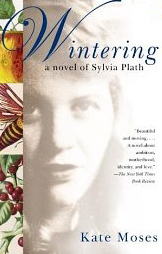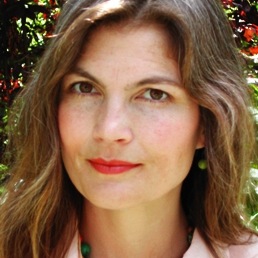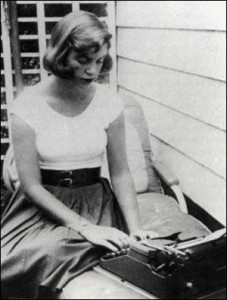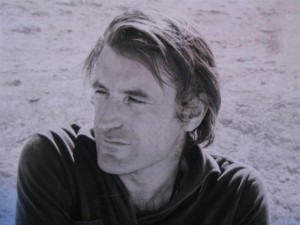“Ariel: a spirit of poetry, lioness of god, sacrificial altar, birth of the immaculate soul-it was all coming together, now and now and now, hoofbeats pounding…..The muse hangs over [Sylvia’s] life like a moon. She will ride this fate right through to a fiery ecstasy, to a resurrection on a hill, a self that was naked and real.” -from Wintering, by Kate Moses.
Most reader s who come to this book will already be familiar with the basic story of poet Sylvia Plath and her doomed marriage to author Ted Hughes. In her final collection of poems, the Ariel poems, of which the poem “Wintering” is a part, Plath depicts the “real and bloody sacrifice” of this marriage, “not bodies piled in a mountain pass but her life…the truths fanning out a page at a time.”
s who come to this book will already be familiar with the basic story of poet Sylvia Plath and her doomed marriage to author Ted Hughes. In her final collection of poems, the Ariel poems, of which the poem “Wintering” is a part, Plath depicts the “real and bloody sacrifice” of this marriage, “not bodies piled in a mountain pass but her life…the truths fanning out a page at a time.”
Married six years by the spring of 1962, Sylvia Plath and Ted Hughes were restoring Court Green, a thatched-roof manor house in Devon, where they lived with their two babies. Sylvia, not quite thirty, was gardening and making the near-ruin of their house into a home, plunging her gloveless hands into the soil, keeping bees, gathering honey, growing apples, and reveling in the sight and smell of fields of wild daffodils, daisies, roses, honeysuckle, Asiatic poppies, and jasmine. By alternating child care duties, both writers had some free time to continue writing, with Sylvia “cultivating her words like fragile cuttings, nursing them to root in their windowsill jam jars.” But even then, when she thought that things were perfect and that the summer of her own creative flowering had arrived, she was uneasy, not because of her life’s abundance, but because of “the idea of loss that exists alongside [the abundance], like some terrible hibernating animal nested within her walls.”

That summer Ted’s affair with Assia Wevill became public, by the fall the marriage was emphatically over, and by December, Sylvia had moved the family from Devon to London to a flat once occupied by William Butler Yeats. In a frenzy of writing in the late fall, she produced thirty finished poems in thirty days, her poems coming to her “like truths, every word taut and hard.” With one book of poetry already published, a potboiler novel, The Bell Jar, about to come out, and a second book of poetry now nearly finished, Sylvia was creatively on fire, writing the poems which became the collection known as Ariel. Six weeks later, she turned on the gas in the kitchen stove and committed suicide, at age thirty.
***
In Wintering, her debut novel, Kate Moses recreates the heart, soul, and psyche of Sylvia Plath, a feat that is so extraordinary and so realistic in its execution that it is difficult to know where to start in describing it. In preparation for this novel, Moses did as much research as many doctoral candidates do, reading virtually every piece of Plath’s writing, both public and private, and most, if not all, of the resource material about Plath — her journals and letters, comments by contemporaries, letters to and from her mother, her daily calendars, audio recordings, biographies, manuscripts, notes by Ted Hughes, and even her baby book. So completely did she distill this material that the reader of the novel feels as if she or he is actually entering the mind of Plath, a Plath who is speaking and reminiscing, conjuring up events, aching, dreaming, and hoping. Astonishingly, Moses achieves this without ever deviating from a third person narrative and without ever speaking as Plath herself.
debut novel, Kate Moses recreates the heart, soul, and psyche of Sylvia Plath, a feat that is so extraordinary and so realistic in its execution that it is difficult to know where to start in describing it. In preparation for this novel, Moses did as much research as many doctoral candidates do, reading virtually every piece of Plath’s writing, both public and private, and most, if not all, of the resource material about Plath — her journals and letters, comments by contemporaries, letters to and from her mother, her daily calendars, audio recordings, biographies, manuscripts, notes by Ted Hughes, and even her baby book. So completely did she distill this material that the reader of the novel feels as if she or he is actually entering the mind of Plath, a Plath who is speaking and reminiscing, conjuring up events, aching, dreaming, and hoping. Astonishingly, Moses achieves this without ever deviating from a third person narrative and without ever speaking as Plath herself.
Organizing the novel around the poems which make up the Ariel collection, all written in the last four months of Plath’s life, Moses creates a fictional narrative using as chapter titles the names of poems from Ariel, each chapter including some of the imagery from these poems and the subject matter from Plath’s life which parallels them. Moses does this naturally, simply letting the narrative unfold in parallel with the essence and imagery of the poems, a process which feels, remarkably, as if it’s unfolding of its own accord. The poems which serve as the impetus to each chapter live on after forty years, continuing to speak to the reader across time and space, and Moses wisely keeps her own narrative in the present tense, suiting her style to that of Plath’s poetry. Like the poems, the chapters sieze on images and events in random order, making Moses’s achievement in creating a real and memorable narrative out of the creative chaos truly daunting.
 This is not really a novel about Plath, so much as it is a novel in which Plath reveals herself, something she does to even greater effect in her poetry. Because of this, I would strongly urge the reader to find a copy of Plath’s Ariel to read in concert with Moses’s Wintering. Images from the poems take on added significance when they are repeated and expanded in Moses’s narrative.
This is not really a novel about Plath, so much as it is a novel in which Plath reveals herself, something she does to even greater effect in her poetry. Because of this, I would strongly urge the reader to find a copy of Plath’s Ariel to read in concert with Moses’s Wintering. Images from the poems take on added significance when they are repeated and expanded in Moses’s narrative.
Although Ted Hughes edited Plath’s poems and changed the order in which they appeared in the final published edition of Ariel, Moses restores them to their original order in her novel. In an irony not lost on the reader, Moses notes that “When [Plath] was ready to type the final version [of the poem “Wintering”]…she put away the [early draft] chapters of The Bell Jar, which she was using as scrap paper for typing the poems. She reached, instead, for pages from Ted’s play, The Calm…his answer to Shakespeare’s The Tempest… She wants her fingerprints all over his page: her page, her words, her survival.” Ultimately, she achieves her goal. Her story, even with its sad ending, is a woman’s story, and her poems–her words–do survive. She even succeeds in having “her fingerprints all over his page” — no one will ever think of Ted Hughes or his writing without also thinking of Sylvia Plath. (On my Favorites list for 2003)
Notes: The author’s photo by Ramona Pederson appears with a brief bio on http://www.narrativemagazine.com
The photo of Ted Hughes as a young man appears on http://www.poems.net.au
The image of Plath typing appears on http://pistolpete.wordpress.com
